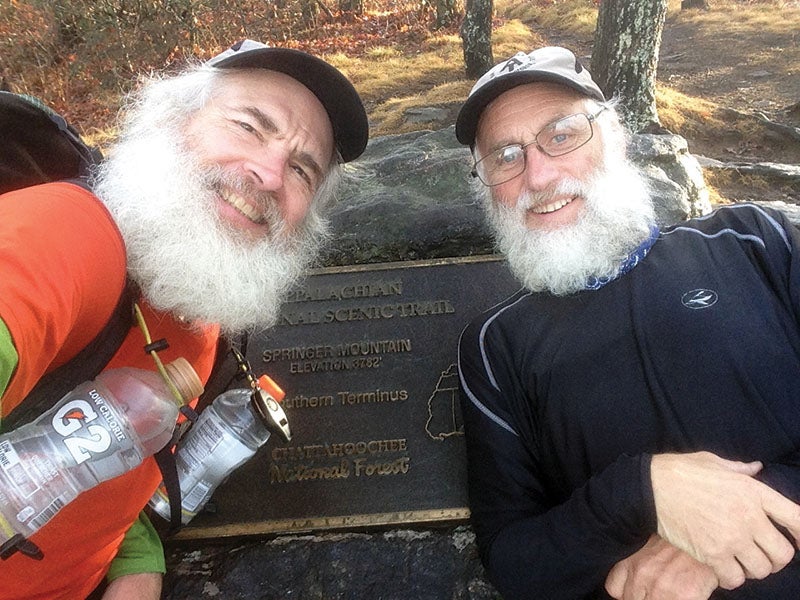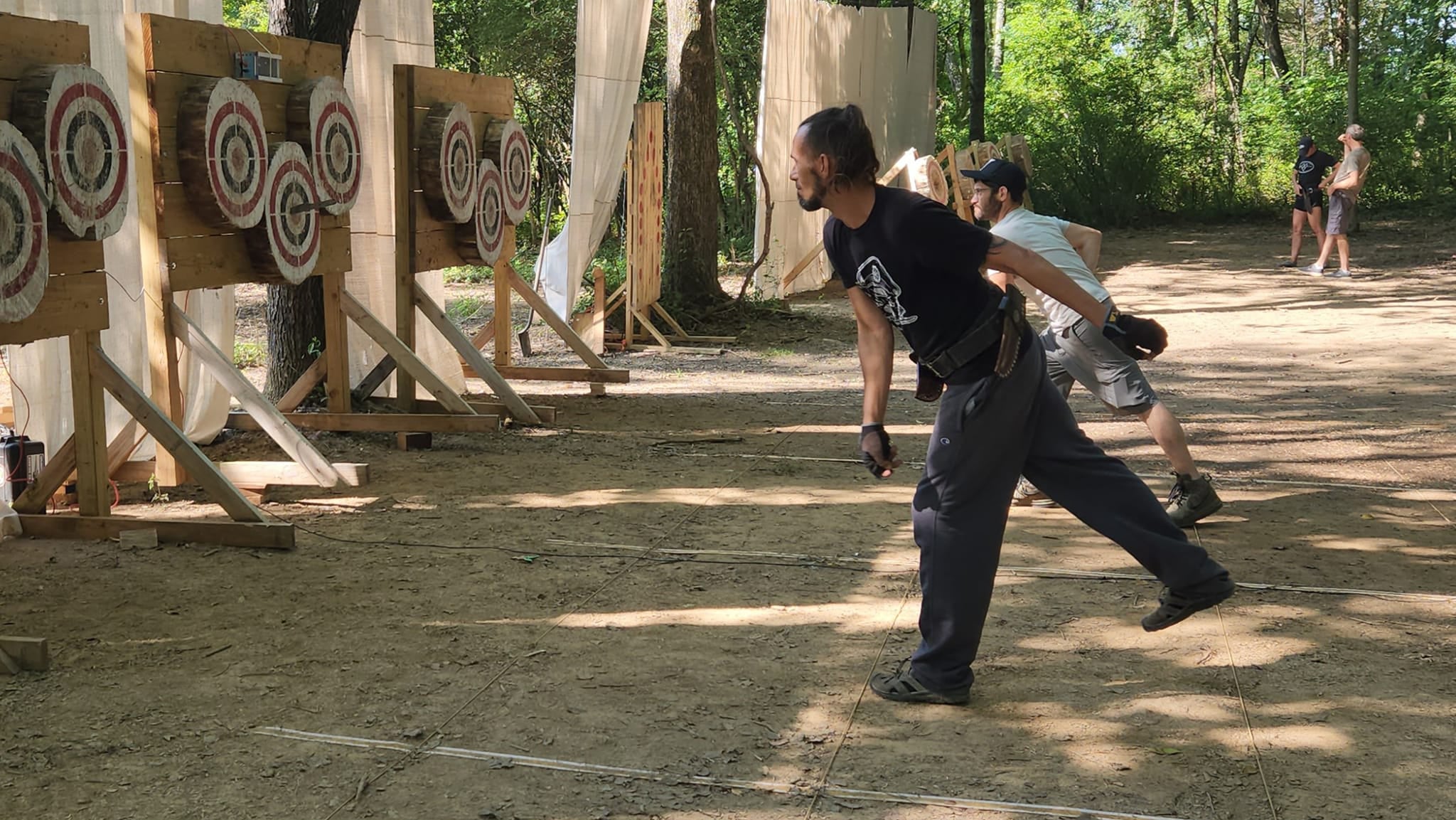Buffalo and Budget’s big adventure: In tough year for hikers, Salisbury men conquer Appalachian Trail
Published 12:00 am Sunday, February 26, 2017

- Submitted photo Mark Schiemann, left, and Bruce Kolkebeck pause next to the marker at Springer Mountain, Ga., signifying the end to their Appalachia Trail journey on Dec. 5, 2016.
By Mark Wineka
mark.wineka@salisburypost.com
SALISBURY — Any serious hiker requires a trail name. Mark Shiemann became known as “Buffalo,” short for water buffalo because he was constantly drinking H2O.
Bruce Kolkebeck labeled himself “Budget,” a recognition of all the used equipment he relied on. “Which failed, by the way,” he adds quickly.
It’s difficult to decide what was the most impressive part of Buffalo and Budget’s conquering of the Appalachian Trail in 2016. The men are older than most people who take on the 2,189.5-mile AT, which extends through 14 states from Georgia to Maine, or in the Salisbury hikers’ case, from Maine to Georgia.
Schiemann is 59 and a retired pensioner with General Electric; Kolkebeck, 63, was the longtime manager of Salisbury’s Baja Products plant, which had closed prior to their trek.
Going into their adventure, both men were veteran hikers, owing to their many years of service as Scout leaders. With his Troop 442 Scouts, Kolkebeck has hiked five times in Philmont, the high adventure ranch in the Rockies of New Mexico. Schiemann has gone with the Scouts to Philmont three times.
They also are well familiar with trails through the Blue Ridge Mountains of North Carolina and Virginia and have taken countless trips to the nearby Uwharries. But nothing quite prepares you for the rigors and relentlessness of a through hike on the Appalachian Trail.
They suffered terrible falls. They lost weight to the point where both men, with their full white beards, looked dangerously emaciated. Schiemann had to come off the trail at different points to have both emergency oral surgery and a root canal.
“I was sure I was going to die,” Schiemann says of how he felt near Rutland, Vt., before he had an impacted wisdom tooth removed in Pittsfield, Mass. He would end up seeing five dentists in five different states during the trip.
Kolkebeck dealt with a troublesome knee requiring prescribed steroids to relieve some of the discomfort. Both men nursed gashes, scrapes, cuts and bruises. As with any through hiker, they confronted bugs, poison, wildlife and being hot, cold, wet, dirty and homesick.
Kolkebeck and Schiemann also decided to hike the Appalachian Trail in a southbound, Maine-to-Georgia route, generally recognized as the tougher way to do it. It was 30 days before they hiked through Maine, which has its share of rocky terrain and the Hundred Mile Wilderness.
Buffalo and Budget took 60 days to cover just the first 500 miles. By comparison, Schiemann notes, they put the second 500 miles behind them in 30 days.
But the men also hiked during a period, from June 15 to Dec. 5, when most of the areas they were passing through were in drought conditions, making it difficult at times to find water. Then the toughest, most dangerous part of their journey came in November, when the forest fires spread through the mountains of North Carolina, Virginia and Tennessee.
“We actually saw South Mountain State Park blow up,” Kolkebeck says of their vantage point one day from the trail. “The more south we got, the worse it grew.”
Increasingly, the men heard news and hiked amid the smoky evidence of fires off in the distance. Schiemann says he kept trying to reassure the families back in Salisbury that for many days they were actually closer to the fires than the hikers.
But soon long sections of the trail were closing, such as the trail from Rock Gap, N.C., to Dick’s Creek Gap, Ga. At Davenport Gap, the men realized they had to leave the trail and go home for Thanksgiving, discouraged their quest had been derailed.
At the end of November, after a six-day holiday break, Kolkebeck and Schiemann drove to the beginning of the trail in Georgia (Dick’s Creek Gap). Over the next five days, they walked to the end of the AT on Springer Mountain.
Because the Appalachian Trail Conservancy had advised them to bypass most of North Carolina, the men learned they still would receive their 2,000-mile badge and a certification for having completed the entire AT.
Kolkebeck calculates they were maybe less than 100 miles short of their goal of completing the entire AT and, of course, they can always return and hit the sections they were forced to avoid in 2016. They are still registered as through hikers.
“I have to sit down and work it out,” Kolkebeck says of the distance left. “… I’m going back. I’m going to go get it.”
Schiemann says he discovered hiking the AT led to “a whole bunch of spirituality in it for me, a whole lot of travel karma.” In hindsight, in asking him to hike the AT, Kolkebeck had given him a gift, Schiemann says.
On the trail, Schiemann learned better how to manage his Type 2 diabetes, the men became best friends, and Schiemann couldn’t believe the support he received during the trip from family, church members, trail angels, the folks at Rowan Vocational Opportunities (where he often helps out) and even his mom’s church in Ohio.
“That’s an incredible feeling that you’ve really done something amazing — and a huge sense of accomplishment,” Shiemann says.
Kolkebeck says the AT experience left him feeling that nothing in everyday life is too difficult to take on. The Appalachian Trail forced him away from 35 years in the same job and 40 years in the same town.
“I wanted to throw my comfort zone way out of whack and, boy, did I,” he says.
Kolkebeck still carries a shade of disappointment in his voice about the fires and having been forced off the AT, though the ATC technically certified their through hike.
“I felt cheated a little bit,” Kolkebeck says.
The men can’t say enough positive things about the trail culture they lived and the people they met — all with nicknames, of course.
“It’s all about the people, it really is,” Kolkebeck says.
They speak of “Grandpa,” who always cooked on an open fire. They hiked significant miles with “Onepiece,” an EMT from Maine; “Gumby Bear,” a middle school teacher; “Hiccup,” a woman hiker from Boone; and “Lost Rhino,” who had a tendency to lose his way.
They mention “Walking Bear,” a 27-year-old German biology student. They also met a couple of guys older than they were, including 67-year-old “Jeremiah” and 76-year-old “Sojo.”
Most of the hikers sharing the trail with them were in the their mid-20s. The men say they saw a lot of recently graduated high-schoolers walking sections of the trail and many Ivy League school freshmen bonding as part of their college orientations.
Also well represented were different nationalities, including Koreans, Germans and French Canadians, according to Shiemann and Kolkebeck.
For the record, here are some of the things you probably are wondering about:
• How much weight did they drop? Kolkebeck shed 35 pounds and weighed 155 the day he left the trail in November. Schiemann went from 195 to 165 pounds.
“In the end, we looked like stick people,” Kolkebeck says. “Skin was hanging off my body.”
• What did they eat? They ended up craving protein and tried to provide themselves with as many calories as possible, though they always seemed to be running a deficit. A typical lunch might be a tortilla wrapped around pepper jack cheese, peanut butter, spam and crushed potato chips.
Kolkebeck says he ate about three or four Clif bars a day.
• Where did they sleep? They spent nights in individual tents next to the trail shelters or in the shelters themselves. They also spent time in trail hostels.
• What was the longest distance they covered in one day? Kolkebeck says they hiked 27 miles in 11 hours when they were able to slack-pack on one occasion. On another day, they covered 26 miles with full packs.
• How did they keep in contact with their families? Overall, cellphone reception was not too bad, though sketchy at times. They met their wives and grown children on several occasions at prearranged locations.
Joshua Shiemann, 24, hiked with his dad for a week in Vermont. The men also left the trail for a brief period in New Jersey so Kolkebeck could attend the wedding of his older brother.
The men relied on the Guthook AT Guide cellphone application and a softbound AT trail guide to keep up with their progress on the trail.
• What equipment did they rely on? They used the typical hikers’ gear, including trekking poles. Each man went through about four pairs of hiking boots.
• What kind of wildlife did they see? Budget and Buffalo hiked by lots of deer; saw 14 bears, including three young cubs that fell out of tree in front of them; three rattlesnakes; porcupines; and skunks.
• Best trail experience? Scouts and other adult leaders of Troop 442 met the men on the AT near Bland, Va., one of the great highlights of an amazing adventure overall.
“It was awesome,” Kolkebeck says.
Contact Mark Wineka at 704-797-4263.





